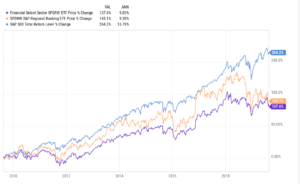The Financial sector has been an overweight for some time in client accounts, and it’s hurt performance the last two years, or since Jan 1 ’18.
Client’s biggest financial weighting has been Schwab given its asset-gathering prowess (and it is our only 3rd party client custodian) and then JP Morgan, Chicago Merc (CME), the XLF (big bank ETF) and unfortunately the KRE (regional bank ETF).
Bill Nygren the famed OakMark Fund Value manager had this to say to Christine Benz in a Morningstar podcast on where Bill and the OakMark Select Fund was seeing value today:
” At the other extreme, the banks have rarely sold at less than half the S&P multiple where they’re at today. They sell, a lot of them, around tangible book value, single-digit P/Es, yet, are much better businesses than they have been for the past decade or so–better lending standards, higher capital ratios, more of a competitive advantage from technology. That ratio of bank stocks to electric utilities to pay half as much on a multiple basis for banks as you would for an electric utility I think is an incredible value.
It’s not like we think that loan growth is suddenly going to skyrocket to double-digit levels. A bank like Bank of America was just given approval to buy back 11% of their stock over the next year, and they’re not digging into capital to do that. That’s just the capital that they will be generating over the next year, and that’s in addition to a dividend yield of about 3%, which is about all you’re getting on electric utilities, anyway.
So, I think the opportunity for a long-term investor to create a portfolio today of dramatically undervalued names and to void some sectors that look pretty fully valued should create an opportunity to meaningfully outperform the rest of the stock market. We don’t think the rest of the stock market is overvalued.”
Nick Colas and Jessica Rabe on their newly-launched and always insightful blog, “DataTrek Morning Briefing” wrote last night that:
#2: While US banks have fared much better than their European counterparts over the years, recent worries over structurally low/declining interest rates have taken a real toll on their stocks:
- The S&P Bank Index, an even-weight measure of 90 public equities, is down 17% over the last year in price terms (i.e. near bear market territory). Six points (35%) of that decline have happened in just the last month.
- Valuations for the largest US banks are very low, at 9-12x expected earnings versus 17.5x on the S&P 500: JP Morgan (10.4x forward earnings, 3.0% dividend yield), Bank of America (9.0x, 2.7% yield), Wells Fargo (9.8X, 4.6% yield), Citigroup (7.5x, 3.2% yield), and US Bancorp (11.8x, 2.8% yield).
Nick was writing about the European bank stock chart, which many think does not look good, so will US banks be a safe haven for those looking for global financial exposure or will US banks get dragged down by the European bank mess. (Frankly, I have no opinion on that.)
Here’s a long-term chart of the XLF, and KRE versus the SP 500 total return:

According to this chart, the XLF and the KRE have under-performed the SP 500 for the last 10 years, but also for 5 years, 3 years 1-year and YTD ’19. (Like Bill Murray in CaddyShack, at least i have that going for me.)
CME has been a decent performer, as has ICE, i.e. both have made all-time-highs with the SP 500.
It’s tough to sell the KRE here even with the yield curve in this kind of shape. In investing, everything changes (eventually).
Summary / conclusion: What worries me is that i was studying Money & Banking in 1980 when Paul Volcker was moving the fed funds rate around like a matador waves a cape at a bull, and Fed Funds reached 20% during the time I was studying monetary policy from a Cincinnati Fed professor. Now, like the money supply in the late 1980’s, I worry that monetary policy is becoming completely irrelevant, in that it’s effect on the US economy seems to be diminishing over time. Housing fell flat in late ’18 after the FOMC raised rates – what, 9 times – between December ’15 and December ’18 but otherwise the economy never really blinked. Is that because of generational low interest rates ?
To think that the FOMC / Fed is cutting rates again after the fed funds rose to only 2.5% and we’re on the way back down, makes me want to yell into the Chicago night “Are you bleeping kidding me ?”
After 2008, the inevitable disintermediation of the traditional banks began after the Obama Administration put the “Dirty, Rotten Scoundrel” – like genital cuff around the banking system and forced banks to raise capital and reduce leverage after the worst consumer recession since the the Great Depression. All that did was force private companies to start lending and taking credit opportunities away from the traditional financial intermediaries.
It is puzzling why – with such a strong consumer and housing credit market and such low loss delinquencies – the banks can’t respond better to strong earnings growth.
The Financial sector has the 3rd best earnings growth of any SP 500 sector for Q2 ’19:
- Communication Services: +17.1%
- Health Care: +10.2%
- Financials: +10%
- Real Estate: +4%
- Cons Spls: +1.4%
- Utilities: +1.1%
- Cons Disc: +0.9%
- Technology: -2.8%
- Energy: -9%
- Industrials: -9.1%
- Materials: -12.7%
- SP 500: +2.9%
What’s maybe even more remarkable, Finanial’s “expected” +4.7% for Q3 ’19 expected earnings is the highest rate of earnings growth of the 11 sectors.
Thanks for reading.
